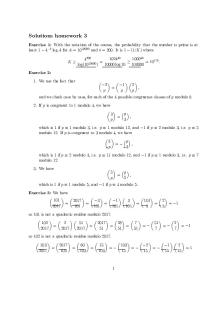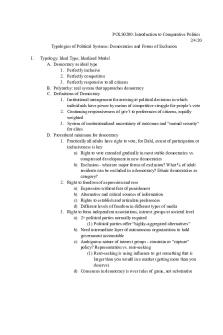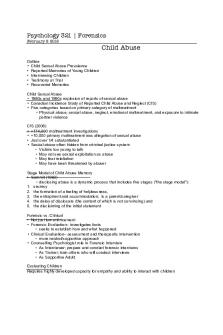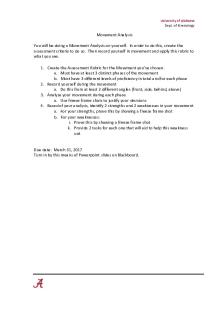Examination in Chief - Taught by Dr. Yvonne Daly PDF

| Title | Examination in Chief - Taught by Dr. Yvonne Daly |
|---|---|
| Course | Law of Evidence |
| Institution | Dublin City University |
| Pages | 6 |
| File Size | 135.5 KB |
| File Type | |
| Total Downloads | 108 |
| Total Views | 132 |
Summary
Taught by Dr. Yvonne Daly...
Description
TOPIC 4:
EXAMINATION-IN-CHIEF
During the course of legal proceedings, the parties strive to prove the existence of some facts and negative the existence of other facts. Witnesses are the primary source of facts in our trial system. Although we speak of lawyers "presenting evidence" to the court, they do not do so in the literal sense but instead elicit testimony from witnesses who have firsthand knowledge of the facts in dispute. The examination of witness unfolds in three distinct phases which are reflective of the adversarial exchange at trial. Examination in-chief involves the questioning of a witness by counsel representing the party that has called the witness. Through a series of questions, counsel seeks to obtain from the witness, testimony that will support the party's version of events. After examination-in chief, any other party to the proceedings has the option of cross-examining the witness. The object of crossexamination is to test the witness by challenging his or her account and undermining his or her credibility. A witness may be cross-examined as to any matter that is relevant to the proceedings, over and above any matters raised during examinationin-chief. After cross-examination, the party that originally called the witness may conduct a re-examination of the witness. When testifying, the witness must limit his or her testimony to a firsthand account, i.e. to matters which the witness has seen, heard or perceived. Furthermore, the witness must not draw inferences from the facts or offer opinions about matters material to the proceedings because these are the very functions entrusted to the finder of fact (whether judge or jury). We will consider four aspects of the law relating to examination-in-chief and reexamination: leading questions, the practice of refreshing memory, the rule against narrative, and the procedure governing hostile witnesses. Heffernan (with Ni Raifeartaigh), Evidence in Criminal Trials (2014) chs 2 & 3 Heffernan, Ryan and Imwinkelried, Evidentiary Foundations (2008) pp.15-20 Heffernan, Evidence: Cases and Materials (2005) ch.3.B Healy, Irish Laws of Evidence (2004) chs.2.II McGrath, Evidence 2nd ed (2014) ch.3.D, F, G & H Leading Questions During examination-in-chief, the witness is questioned by counsel representing the party that has called the witness to testify. The rules relating to examination-in-chief are designed to ensure that the evidence provided is the witness’s own independent evidence. One way in which the law safeguards against counsel unduly influencing the witness is by imposing a ban on questions that lead the witness. This contrasts with the position in relation to cross-examination, where counsel is free to ask questions that box the witness in, i.e. that limit the scope of the witness’s answer. If the witness is forced to answer “yes” or “no” to a particular question, then this is often taken as a sign that the question may be a leading question. However, McGrath cautions that “the dividing line between leading and non-leading questions 1
is not always clear and there is no ready test available to distinguish the two” (p109, para.3.74). In realtity, there are two forms of leading question: (a) a question that suggests a desired answer; and (b) a question that assumes the existence of a fact that is in dispute between the parties. There are some exceptions to the ban on leading questions that are mostly designed to speed-up examination-in-chief. For example, counsel can lead the witness on introductory matters such as the witness’s identity and occupation. DPP v Hawkins [2014] IECCA 36 (29 October 2014) Refreshing Memory Courts generally decide facts on the basis of evidence that is presented directly in open court through examination-in-chief and tested through cross-examination. There is a clear preference for live, oral testimony over evidence of statements that the witness on a previous occasion. One of the limited purposes for which courts permit witnesses to refer to pre-trial statements is to refresh their memory of the events that gave rise to the proceedings. Refreshing memory may take place in two ways. First, a witness may use a pre-trial statement to refresh her memory while she is on the stand testifying at trial (refreshing memory in-court). Second, she may refer to a pre-trial statement when preparing to come to court and testify (refreshing memory out-of-court). The courts have set down conditions that apply to each of these practices of refreshing memory. Heffernan (with Ni Raifeartaigh), Evidence in Criminal Trials (2014) pp.50-57 McGrath, Evidence, 2nd ed. (2014) pp.133-139 Newark & Samuels, “Refreshing Memory” [1978] Crim L Rev 441 Lord Malahide v. Cusack [1864] 17 Ir. C.L.R. 213, Casebook p.95 Northern Banking Co. v. Carpenter [1931] I.R. 268, Casebook p.97 D.P.P. v. Clifford [2002] 4 I.R. 398, Casebook p.98 DPP v McGinley [2013] IECA 7 (14 March 2013) R v Richardson [1971] 2 QB 484, Casebook p.100 People (D.P.P.) v. Donnelly (CCA 22 February 1999), Casebook p.102 The issue of refreshing memory out-of-court is linked to the broader question of witness preparation, i.e. are there limits to the ways in which a witness may prepare to testify at trial? For an interesting case on point, see the judgment of the High Court in O’R v DPP [2011] IEHC 368 (7 October 2011). In that case, the accused sought to have his trial for sexual violence stopped on the ground that the victim of the offence had allegedly been coached as to how she should give evidence. The International Criminal Court has considered the extent to which counsel may assist a witness in preparing to testify, a practice which the ICC refers to as “witnessproofing”. If you are interested in reading more about this, see the decisions of the Court in Prosecutor v Lubanga (ICC Trial Chamber, 8 November 2006 and 30 November 2007). Rule Against Narrative: Doctrine of Recent Complaint
2
Because our law emphasises live testimony in open court, witnesses are not generally permitted to refer in their testimony to previous statements that they made before coming to trial. The rule against narrative states that a witness may not be asked in examination-in-chief about previous statements that she made, whether written or oral, that are consistent with her testimony at trial. The primary purpose of the rule is to prevent a witness from using a fabricated statement to bolster her evidence at trial. But even putting aside something as serious as the fabrication of evidence, the rule is said to ensure that the evidence on which the court relies is the witness’s testimony rather than a statement that was neither delivered nor challenged directly before the court. There are several exceptions to the rule against narrative. One notable exception is the doctrine of recent complaint which applies in trials for sexual offences. This exception allows a complainant to testify about the fact that she complained to a third party about the alleged offence as soon as was reasonably possible. This evidence is said to enhance the complainant’s credibility. However, the doctrine is subject to certain conditions and has been criticised as a common law anachronism. People (DPP) v Brophy [1992] 1 ILRM 709, Casebook p.104 People (DPP) v DR [1998] 2 IR 106, Casebook p.107 People (DPP) v MA [2002] 2 IR 601, Casebook p.109 Heffernan (with Ni Raifeartaigh), Evidence in Criminal Trials (2014) pp126-131 McGrath, Evidence, 2nd ed. (2014) Ní Raifeartaigh, "Doctrine of Fresh Complaint in Sexual Cases" (1994) 12 ILT 160 Foley, "Hearsay and Recent Complaint" (2001) 15 ILT 234 Foley, “The Doctrine of Recent Complaint Revisited” (2001) 11 ICLJ 20 Unfavourable Witness - Disappoints the party that called the witness - Party cannot impeach their own witness - Can present other evidence to redress damage Hostile Witnesses When a party calls a witness to give evidence, the party expects the witness to give evidence that will assist the party’s case. If a witness turns out to be unfavourable, there is nothing that the party can do other than call additional witnesses. However, if the witness is hostile, i.e. he or she intentionally frustrates the party’s cause, the party can apply to the trial judge for permission to conduct examination-in-chief in the manner of cross-examination.
treat witness as hostile impeach with previous statement admit previous statement as evidence requires permission of the TJ. TJ’s decision not open to appeal. TJ considers the witness’ attitude and demeanour. Exam in chief becomes cross-exam.
S. 3 of the Criminal Procedure Act 1865, Casebook p.111
3
People (AG) v Hanigan [1941] IR 252 O’Flynn v Judge Smithwick [1993] 3 IR 589 People (A.G.) v. Taylor [1974] I.R. 97, Casebook p.111: sets out procedure People (DPP) v Cunningham [2007] IECCA 49 (24 May 2007): discretion of the TJ DPP v Hanley [2011] 1 IR 241 Heffernan (with Ni Raifeartaigh), Evidence in Criminal Trials (2014) ch 5 Newark, “The Hostile Witness and the Adversary System” [1986] Crim LR 441 Pattenden, “The Hostile Witness” (1992) 56 Journal of Criminal Law 414 Please consult the handout on Seminar 3: Previous Witness Statements and section 16 of the Criminal Justice Act 2006 Impeaching the witness by previous statement - s3 of the Criminal Procedure Act 1865 o put the fact of the statement to the witness o if witness denies statement, prove that statement was made o Put the contradiction to the witness o Admit the statement into evidence but only for the purpose of proving the contradiction (McArdle [2003] IR) - Contradict witness with previous inconsistent statement - Only applies where a witness testifies and his testimony is adverse Part 3 CJA 2006 S.16(1) provides that “a statement relevant to the proceedings” may be admitted where the witness: (a) refuses to give evidence (b) denies making the statement or (c) gives evidence materially inconsistent with it. Admissibility of Statement: Section 16(2) 3 factors 1. the witness confirms or it is proved that he or she made it 2. Court is satisfied that: (i) direct oral evidence of any fact stated would be admissible (ii) the statement was made voluntarily (iii) the statement is reliable 3. Either the statement was given on oath or affirmation or contains a statutory declaration Or the court is otherwise satisfied that the witness understood the need to tell the truth Reliability: s 16(3) (a) Was statement made on oath/affirmation or was video-recorded. (b) Is there is other “sufficient evidence” of reliability (c) Has the witness explained her refusal change of heart. Statement not admitted: s16(4) Interests of justice (including risk of unfairness to an accused) 4
Admission is unnecessary given other evidence Weight of Statement: s16(5) Regard shall be had to “all the circumstances from which any inference can reasonably be drawn as to its accuracy or otherwise” Difficulties Statement is hearsay Limits on cross-examination: at time statement was made and at trial Accused was not present when statement made (natural justice) Questions Does s.16 cover “amnesia cases”? Is the reliability test too high? What about retracted statements? What is the procedure under s.16? How should the judge instruct the jury? Should video-recording of s.16 statements be mandatory? Case Law O’Brien [2010] IECCA 103 Hanley [2010] IECCA101 Murphy [2013] IECCA 1 Rattigan [2013] IECCA 13 Collopy [2016] IECA 149 Smith [2016] IECA 154 Fitzgerald [2016] IECA 222 Re-Examination After cross-examination, the party that called the witness has the option of reexamining the witness. During re-examination, which counsel attempts to minimise any gains secured by the other party (or parties) during cross-examination. The scope of re-examination is limited to matters raised during cross-examination. The same basic rules governing examination-in-chief apply to re-examination. REVISION EXERCISES In Heffernan et al., Evidentiary Foundations: Irish Edition (2008), review the sample foundation relating to examination-in-chief on pages 16-21. Consider the objectives counsel is striving to achieve in the conduct of the examination and assess whether the questions actually posed are adequate to meet those objectives. Compare and contrast the nature and style of examination-in-chief (pages 16-21) and cross-examination (pages 21-26). SAMPLE QUESTIONS
5
1. John has been charged with the assault and battery of his neighbour, Paul. The alleged offence took place on a Saturday evening when John and Paul were chatting on the street. A discussion about a local football match developed into an argument and an altercation ensued. John allegedly punched Paul repeatedly in the face, breaking his nose and fracturing his jaw. A couple of days after the event, Paul wrote down his version of events on an A4 page. Paul is nervous about testifying at the upcoming trial and is having trouble remembering the details of the assault and battery. Advise the prosecution as to whether Paul can refer to the A4 page (a) when preparing for trial and (b) when testifying during the trial itself. 2. Assess the contribution to the law of evidence of the following: (a) People (DPP) v Brophy [1992] 1 ILRM 709; (b) Northern Banking Co v Carpenter [1931] IR 268
3. "The law governing hostile witnesses is nonsensical. Implicit in the act of calling a witness is the party's assurance that the witness will engage with the court. If the witness fails to co-operate, the party should simply be forced to grin and bear it." Discuss.
6...
Similar Free PDFs

Practice Examination in AUD6
- 25 Pages

Midterm Examination in Rizal
- 4 Pages
Popular Institutions
- Tinajero National High School - Annex
- Politeknik Caltex Riau
- Yokohama City University
- SGT University
- University of Al-Qadisiyah
- Divine Word College of Vigan
- Techniek College Rotterdam
- Universidade de Santiago
- Universiti Teknologi MARA Cawangan Johor Kampus Pasir Gudang
- Poltekkes Kemenkes Yogyakarta
- Baguio City National High School
- Colegio san marcos
- preparatoria uno
- Centro de Bachillerato Tecnológico Industrial y de Servicios No. 107
- Dalian Maritime University
- Quang Trung Secondary School
- Colegio Tecnológico en Informática
- Corporación Regional de Educación Superior
- Grupo CEDVA
- Dar Al Uloom University
- Centro de Estudios Preuniversitarios de la Universidad Nacional de Ingeniería
- 上智大学
- Aakash International School, Nuna Majara
- San Felipe Neri Catholic School
- Kang Chiao International School - New Taipei City
- Misamis Occidental National High School
- Institución Educativa Escuela Normal Juan Ladrilleros
- Kolehiyo ng Pantukan
- Batanes State College
- Instituto Continental
- Sekolah Menengah Kejuruan Kesehatan Kaltara (Tarakan)
- Colegio de La Inmaculada Concepcion - Cebu













